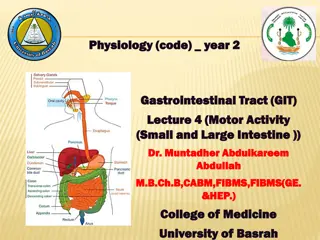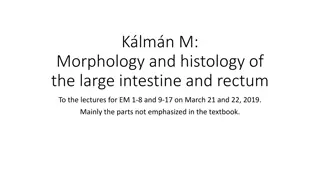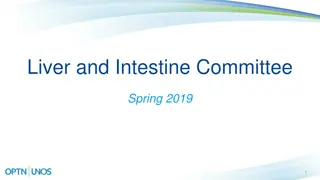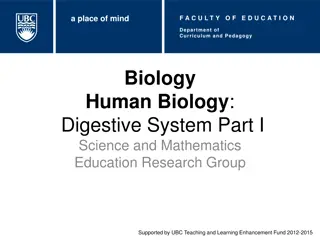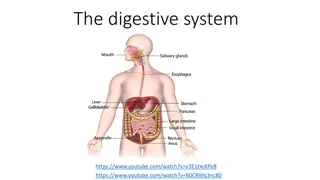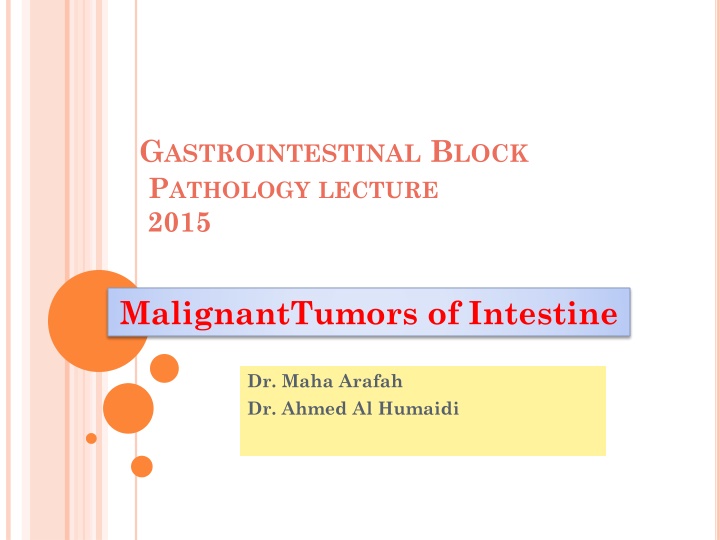
MalignantTumors of Intestine
This lecture discusses the epidemiology, pathology, and prognosis of malignant tumors of the intestine, with a focus on colon cancer. It covers the different stages of colorectal adenocarcinoma, the relationship between CEA and recurrence, and the significance of carcinoid tumors.
Download Presentation

Please find below an Image/Link to download the presentation.
The content on the website is provided AS IS for your information and personal use only. It may not be sold, licensed, or shared on other websites without obtaining consent from the author. If you encounter any issues during the download, it is possible that the publisher has removed the file from their server.
You are allowed to download the files provided on this website for personal or commercial use, subject to the condition that they are used lawfully. All files are the property of their respective owners.
The content on the website is provided AS IS for your information and personal use only. It may not be sold, licensed, or shared on other websites without obtaining consent from the author.
E N D
Presentation Transcript
GASTROINTESTINAL BLOCK PATHOLOGY LECTURE 2015 MalignantTumors of Intestine Dr. Maha Arafah Dr. Ahmed Al Humaidi
Colon cancer: Describe the epidemiology of colon cancer. Compare the pathology (gross and microscopic features) and clinical features of right-sided colonic adenocarcinoma and left-sided colorectal adenocarcinoma. Describe the relationship between prognosis and the various stages of cancer of the colon and rectum as noted in the TNM (tumor-nodes-metastasis) classification and staging system. Describe the relationship between carcinoembryonic antigen (CEA) and recurrence following resection of the primary tumor. Mention the significant of carcinoid tumor and its features
TUMORS OF THE SMALL AND LARGE INTESTINES Carcinoma Carcinoid tumor Lymphoma
Adenocarcinoma of the colon is the most common malignancy of the GI tract and is a major cause of morbidity and mortality worldwide.
The small intestine accounts for 75% of the overall length of the GI tract, is an uncommon site for benign and malignant tumors. Among malignant small intestinal tumors, adenocarcinomas and well-differentiated neuroendocrine (carcinoid) tumors have roughly equal incidence, followed by lymphomas and sarcomas.
MALIGNANT TUMORS OF LARGE INTESTINE Adenocarcinoma Adenocarcinoma of the colon is the most common malignancy of the GI tract and is a major cause of morbidity and mortality worldwide. Constitutes 98% of all cancers in the large intestine. incidence peaks at 60 to 70 years of age
MALIGNANT TUMORS OF LARGE INTESTINE Adenocarcinoma Predisposing factors IBD, adenomas, polyposis syndrome. Diet appears to play an important role in the risk for colon cancer: - Low fibre diet. High fat content. - - It is theorized that reduced fiber content leads to decreased stool bulk and altered composition of the intestinal microbiota. This change may increase synthesis of potentially toxic oxidative by-products of bacterial metabolism, which would be expected to remain in contact with the colonic mucosa for longer periods of time as a result of reduced stool bulk. High fat intake also enhances hepatic synthesis of cholesterol and bile acids, which can be converted into carcinogens by intestinal bacteria. 1. 2. - Alcohol Reduced intake of vit A, C & E. -
Several epidemiologic studies suggest that aspirin or other NSAIDs have a protective effect. This is consistent with studies showing that some NSAIDs cause polyp regression in FAP patients in whom the rectum was left in place after colectomy.
ADENOCARCINOMA OF LARGE INTESTINE Carcinogenesis Two pathogenetically distinct pathways for the development of colon cancer, both seem to result from accumulation of multiple mutations: 1- The APC/B-catenin pathway ( 85 % ) 2- The DNA mismatch repair genes pathway
ADENOCARCINOMA OF LARGE INTESTINE Carcinogenesis 1- The APC/B-catenin pathway ( 85 % ) chromosomal instability that results in stepwise accumulation of mutations in a series of oncogenes and tumor suppressor genes. adenoma-carcinoma sequence
FAMILIAL ADENOMATOUS POLYPOSIS Hereditary mutation of the APC gene is the cause of familial adenomatous polyposis (FAP), where affected individuals carry an almost 100% risk of developing colon cancer by age 40 years.
MALIGNANT TUMORS OF LARGE INTESTINE ADENOCARCINOMA Carcinogenesis 2- The DNA mismatch repair genes pathway (These are referred to as MSI high, or MSI-H, tumors:) 10% to 15% of sporadic cases. There is accumulation of mutations (as in the APC/B-catenin schema) Five DNA mismatch repair genes (MSH2, MSH6, MLH1, PMS1, AND PMS2) give rise to the hereditary non polyposis colon carcinoma (HNPCC) syndrome.
COLORECTAL CARCINOMA Morphology 70% are in the rectum, rectosigmoid and sigmoid colon. Left-sided carcinomas tend to be annular, encircling lesions with early symptoms of obstruction. Right-sided carcinomas tend to grow as polypoid, fungating masses, obstruction is uncommon. Right-sided Left-sided
COLORECTAL CARCINOMA MORPHOLOGY Adenocarcinoma Mucinous adenocarcinoma secret abundant mucin that may dissect through cleavage planes in the wall.
SIGNS AND SYMPTOMS If located closer to the anus: change in bowel habit, feeling of incomplete defecation, PR bleeding A tumor that is large enough to fill the entire lumen of the bowel may cause bowel obstruction Right-sided lesions are more likely to bleed while left-sided tumors are usually detected later and could present with bowel obstruction.
COLORECTAL CARCINOMA Serum levels of carcinoembryonic antigen (CEA) are related to tumor size and extent of spread. They are helpful in monitoring for recurrence of tumor after resection.
TNM STAGING OF COLON CANCERS IS USED FOR STAGING
COLORECTAL CARCINOMA The two most important prognostic factors are depth of invasion and the presence or absence of lymph node metastases.
MALIGNANT SMALL INTESTINAL NEOPLASMS In descending order of frequency: Carcinoid Adenocarcinomas Lymphomas Leiomyosarcomas.
SMALL INTESTINAL NEOPLASMS Carcinoid Tumors Neoplasms arising from endocrine cells found along the length of GIT mucosa. The peak incidence: sixth decade, but they may appear at any age. They compose less than 2% of colorectal malignancies almost half of small intestinal malignant tumors: 60 to 80% appendix and terminal ileum 10 to 20% rectum.
CARCINOID TUMORS BEHAVIOR Aggressive behavior correlates with: Site of origin: Appendiceal and rectal carcinoids infrequently metastasize, even though they may show extensive local spread 90% of ileal, gastric, and colonic carcinoids that have penetrated halfway through the muscle wall have spread to lymph nodes and distant sites at the time of diagnosis, especially those larger than 2 cm in diameter. Depth of local penetration Size of the tumor 1. 2. 3.
SMALL INTESTINAL NEOPLASMS Carcinoid Tumors Morphology A solid, yellow-tan appearance The cells are monotonously similar, having a scant, pink granular cytoplasm and a round-to-oval stippled nucleus. Ultrastructral features: neurosecretory electron dense bodies in the cytoplasm
SMALL INTESTINAL NEOPLASMS Carcinoid Tumor Clinical features Asymptomatic May cause obstruction, intussusception or bleeding. May elaborate hormones: Zollinger-Ellison, Cushing s carcinoid or other syndromes.
SMALL INTESTINAL NEOPLASMS Carcinoid tumor Carcinoid syndrome 1% of carcinoid tumor & in 20% of those of widespread metastasis Paroxymal flushing, episodes of asthma-like wheezing, right-sided heart failure, attacks of watery diarrhea, abdominal pain, The principal chemical mediator is serotonin The syndrome is classically associated with ileal carcinoids with hepatic metastases.
CLINICAL FINDINGS Due to serotonin and other bioactive compounds (e.g., histamine, bradykinin) Flushing of the skin (75% 90% of cases) Due to vasodilation; may be triggered by emotion, alcohol, other foods Diarrhea (>70% of cases) Increased bowel motility from serotonin Intermittent wheezing and dyspnea (25% of cases) Due to bronchospasm Facial telangiectasia Tricuspid regurgitation and pulmonary stenosis Serotonin increases collagen production in the valves.
SEROTONIN AND DIARRHEA Patients with carcinoid syndrome often suffer from diarrhea, which has both a secretory and a motor component. The secretory component of carcinoid diarrhea is attributable to excessive serotonergic stimulation of submucosal secretomotor neurons; the motor component includes faster small bowel and colon transit and an exaggerated tonic response of the colon to ingestion of a meal
SMALL INTESTINAL NEOPLASMS Lymphoma Most often low-grade lymphomas arising in mucosal-associated lymphoid tissue (MALT) lymphoma or high-grade non-Hodgkin's lymphomas of B cell type. May occur in any part of the intestine; The ileocecal region is a favored site for Burkitt's lymphoma.
Left colon, carcinoma - Gross, mucosal surface This specimen from the left colon shows an annular, encircling, and constricting cancer. The margins of the cancer are heaped-up and firm, and the mid- region is ulcerated. Left-sided colon cancers come to attention by producing occult bleeding and changes in bowel habits (i.e., constipation and cramping in the left lower quadrant).
The carcinoma is composed of irregular glands infiltrating the muscularis propria, serosa, and mesentery. The TNM classification is based on the extent of invasion, number of lymph nodes involved, and extent of metastatic involvement. The deeper tumor extends into the muscularis propria, and as lymph nodes become involved, the prognosis worsens. T extent of invasion N number of lymph nodes involved M extent of metastatic involvement
Assuming this patient did not have lymph node metastasis, what stage is this carcinoma? The TNM stage for the current case would be T3N0MX. T3 extends through the muscularis propria N0 no lymph node involvement MX extent of metastatic involvement unknown
malignant glands of an adenocarcinoma of the colon infiltrating the muscularis propria. What is the mode of spread of this cancer? Colonic carcinomas spread by local extension to adjacent structures. The favored sites of metastases are regional lymph nodes, liver, lungs, and bones.
Cecal adenocarcinoma Tumors in the proximal colon tend to grow as polypoid, fungating, ulcerating masses. Obstruction is uncommon. About 25% of colon carcinomas are located in the cecum or ascending colon. Note the adjacent pedunculated adenomatous polyp. Most colon cancers develop from adenomatous polyps (the adenoma-carcinoma sequence). Cecal and right colon cancers most often come to clinical attention by the appearance of fatigue, weakness, and iron-deficiency anemia.











